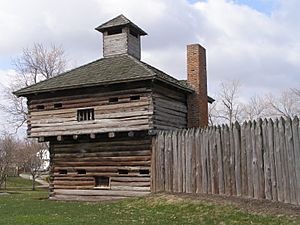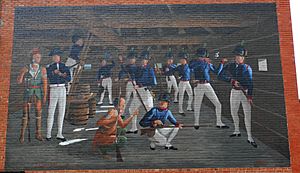Battle of Fort Recovery facts for kids
Quick facts for kids Battle of Fort Recovery |
|||||||||||
|---|---|---|---|---|---|---|---|---|---|---|---|
| Part of the Northwest Indian War | |||||||||||
 Reconstructed Blockhouse at Fort Recovery, Ohio |
|||||||||||
|
|||||||||||
| Belligerents | |||||||||||
Chickasaw Choctaw |
|
||||||||||
| Commanders and leaders | |||||||||||
| MAJ William McMahon † CPT Asa Hartshorn † CPT Alexander Gibson |
Egushawa Blue Jacket Matthew Elliott |
||||||||||
| Strength | |||||||||||
| ~250 | ~1200 | ||||||||||
| Casualties and losses | |||||||||||
| 35 killed 43 wounded 20 missing |
17-50 killed (estimate) 100 wounded (estimate) |
||||||||||
The Battle of Fort Recovery happened from June 30 to July 1, 1794. It was a major fight during the Northwest Indian War. This battle took place at what is now Fort Recovery, Ohio. A large group of Native American warriors from the Northwestern Confederacy attacked a fort held by United States soldiers. The US soldiers lost many people, but they managed to keep control of the fort. This battle showed some disagreements within the Native American Confederacy. After the battle, the United States pushed further into the Northwest Territory.
Why the Battle Happened
After the American Revolutionary War, Great Britain gave control of lands northwest of the Ohio River to the United States. The US wanted to use these lands to pay off debts. However, a group of Native American nations, called the Northwestern Confederacy, wanted to keep the Ohio River as their border. This led to the Northwest Indian War.
In 1791, US forces suffered a big defeat at St. Clair's defeat. Native American warriors from the Lenape, Miami, and Shawnee tribes won this battle. Because of this loss, the United States created a new, strong army called the Legion of the United States. The army's leader, Major General Anthony Wayne, ordered new forts to be built. These forts would protect the supply routes. He specifically chose to build Fort Recovery on the same spot where St. Clair's defeat happened. By June 1794, Fort Recovery had about 250 soldiers. They also had cannons that were found from the 1791 battle.
Around the same time, a large group of the Northwestern Confederacy gathered. They heard that Britain might soon go to war with the United States. Blue Jacket, a Shawnee leader, wanted to use this chance to win the war. He got support from the Shawnee, Odawa, Potawatomi, Lenape, and Ojibwe tribes. However, Little Turtle, a Miami war chief, did not want to attack without cannons. So, most of the Miami tribe did not join this fight.
Blue Jacket did not plan to attack Fort Recovery at first. His scouts were looking for the best place to strike. By June 25, the combined Native American force was close to Fort Recovery. They had so many warriors that there were not enough guns for everyone. They also hunted as they traveled, using up their ammunition.
Scouts were sent out to find US forces. On June 27, some Odawa and Ojibwe scouts met a US group. This US group included Choctaw warriors and army rangers. A US ranger captain was killed, but the rest escaped. They reported a "great force" of Native Americans and white men moving towards the US supply lines. Fort Recovery only had enough food for three days.
On June 28, the Native American forces camped near the road between Fort Recovery and Fort Greenville. They debated their next move. Blue Jacket wanted to attack the supply road south of Fort Greenville. This would cut off supplies to the US forts. But others argued it would be easier to attack Fort Recovery, which was at the end of the supply line. The entire Native American army was placed under the command of Egushawa, an Odawa leader. About 1,200 warriors prepared an ambush just south of Fort Recovery.
The Battle
On the morning of June 30, a group of Choctaw and Chickasaw warriors arrived at Fort Recovery. Their leader, Jimmy Underwood, warned of a large enemy presence. Captain Gibson sent out a patrol, but they found nothing unusual. So, the fort went back to normal, and farm animals were let out to graze.
Later that morning, a supply column left Fort Recovery for Fort Greenville. A small group of Native American warriors attacked this column. They forced the column back to the fort. When the fort heard gunshots, they sent out soldiers to help. These included dragoons (soldiers on horseback) and riflemen.
The main Native American force waited until the dragoons were very close. Then, they fired many shots at once. This killed several dragoons and horses, including Major William McMahon, who was in charge. The riflemen, led by Captain Asa Hartshorn, were surrounded and cut off from the fort. They were then attacked by the main Native American force. Captain Hartshorn was injured. He was killed after refusing to surrender.
Captain Gibson sent another group to help the soldiers retreat to the fort. They fought bravely but were forced to fall back. Many dragoons made it back to the fort, but 32 were killed and 30 were wounded. The Native Americans captured many horses used for supplies.
The Native American forces had only lost 3 warriors in the ambush. However, some Odawa and Ojibwa forces then attacked the fort directly. British officers with the Native Americans argued against this attack. They believed it was too risky and unlikely to succeed against the strong fort. But the attack went ahead.
The fort's defenders, including infantry, dragoons, and Chickasaw scouts, easily stopped the attack. Captain Gibson used the recovered cannons to defend the fort. The cannons did not kill many warriors directly, but they scared some away. The Native American forces refused to leave, though. They stayed near the fort while a British artillery crew looked for cannons buried after St. Clair's defeat. Blue Jacket had to support the attack, which lasted until nightfall.
Chickasaw and Choctaw scouts managed to get behind the Native American lines. They shot some Ojibwe and Odawa warriors in the back. This caused some northern tribes to accuse the Shawnee of firing on them. The scouts also saw British officers in red uniforms and other white men, including Simon Girty, among the Native American commanders. One British officer was shot by a Chickasaw rifleman and later died.
The Native American forces decided to pull back into the forest. They had lost many warriors while causing few losses to the fort. That night, they tried a surprise attack on the fort. It lasted almost two hours but did not achieve much. Shots continued through the night as soldiers in the fort fired at Native Americans gathering their dead and wounded. A scouting group reported that British officers were behind the Native American lines. They had powder and cannonballs but no cannons. They were looking for US cannons buried after St. Clair's defeat, not knowing the US had already found them. The British officers found one cannon but could not use it.
The next day, July 1, some Native American forces attacked the fort again. They began to leave by noon and were gone by nightfall.
What Happened Next
On July 2, Captain Gibson sent out groups to bury the dead. A few remaining Native Americans fired at them, but there was no major fighting. Captain Gibson reported 35 US soldiers killed, 43 wounded, and 20 captured or missing. Also, 46 horses were killed, and the Native Americans captured 204 horses and 30 cattle. General Wayne sent more supplies to the fort, worried the Native Americans might attack again. Wayne arrived at Fort Recovery a month later and praised the soldiers.
Estimates of Native American losses varied. Some reports said 17 were killed, while later reports claimed 130. William Wells, a scout, believed between 40-50 had died and nearly 100 were wounded.
The leaders of the Western Confederacy were very divided after the battle. The Odawa accused Blue Jacket of being a coward for not fully supporting the direct attack on Fort Recovery. Blue Jacket was angry that his plan to attack Fort Greenville was rejected. He was also upset that the Odawa attacked Fort Recovery directly after their first success. The Odawa and Ojibwa tribes left to go home and bury their dead. They felt they had done their part for the Confederacy.
British Major William Campbell, who commanded Fort Miami, asked for more soldiers when he heard about the battle. Governor John Graves Simcoe believed war was now "inevitable." Little Turtle called Wayne a "black snake who never sleeps." He asked the British for 20 soldiers and 2 cannons to attack Fort Recovery again. But the British commander in Detroit, Colonel Richard England, refused to promise this help. Little Turtle then warned him that they could not keep fighting Wayne's army.
Because Fort Recovery remained secure, Wayne's army could move further north. Fort Defiance was built in August. It became the main base for Wayne's army. Later, Wayne's army defeated a combined Native American force led by Blue Jacket at the Battle of Fallen Timbers. The next year, representatives from the Western Confederacy and the United States met. They signed the Treaty of Greenville. This treaty gave most of what is now Ohio to the United States. Fort Recovery was used as a landmark to draw the new border with Native American lands.
Tecumseh, a famous Shawnee leader, was among the warriors at Fort Recovery. He later fought at Fallen Timbers. In 1808, he would form a new large group of Native American tribes to resist the US.
Images for kids
-
Reconstructed Blockhouse at Fort Recovery, Ohio




